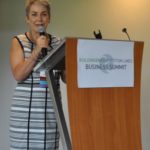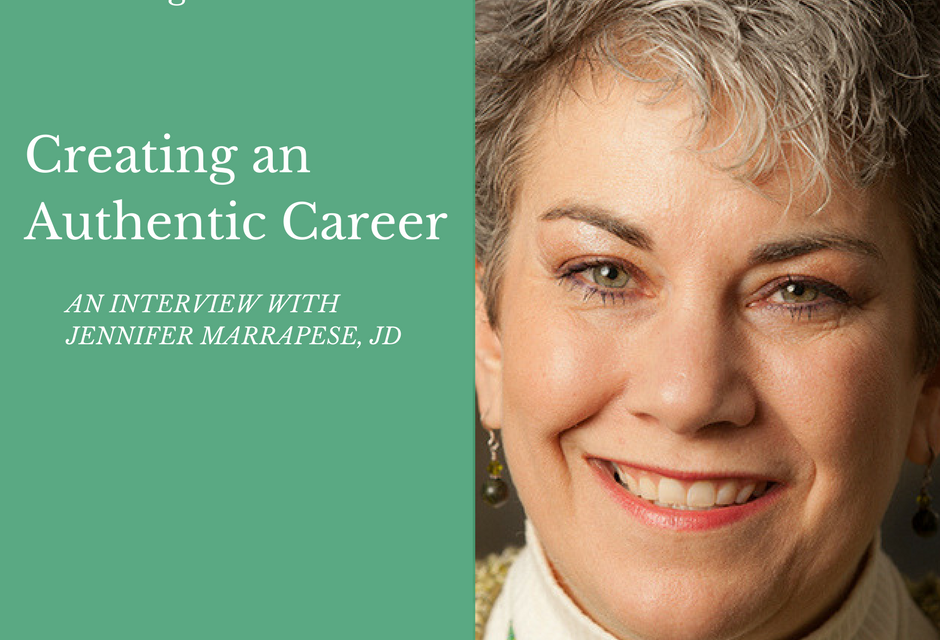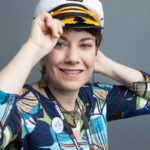When I look for individuals with a thriving career that matches their beliefs and values, Jennifer Marrapese tops my list. I’ve had the pleasure to call her friend for over 15 years since I met her in graduate school and was attracted to her insightful comments, quick wit,  and funky vintage clothing. Jennifer is a natural leader, full of creative ideas and interests, and is always learning. Jennifer serves as Executive Director for the Northeast Sustainable Energy Association (NESEA), a membership organization of professionals involved in green building and renewable energy. Her organization serves thousands of members who are focused on making buildings and communities as energy efficient and resilient as possible while improving their respective “triple bottom lines” (in other words, optimizing their “people” and “planet” practices, not just their financial profitability). In this interview we discuss her path to leadership that aligns with her values.
and funky vintage clothing. Jennifer is a natural leader, full of creative ideas and interests, and is always learning. Jennifer serves as Executive Director for the Northeast Sustainable Energy Association (NESEA), a membership organization of professionals involved in green building and renewable energy. Her organization serves thousands of members who are focused on making buildings and communities as energy efficient and resilient as possible while improving their respective “triple bottom lines” (in other words, optimizing their “people” and “planet” practices, not just their financial profitability). In this interview we discuss her path to leadership that aligns with her values.
Q. Tell us a bit about your role as the Executive Director at Northeast Sustainable Energy Association.
JM: My job as ED is akin to that of an orchestra conductor. I work with the board of directors to make sure that the organization has a current strategic plan, informed by the needs of our members and other stakeholders, and that we have the financial resources to implement that plan. I hire phenomenally talented people to run our programs and provide them with the tools and support they need. One of the biggest things I do is stay out of their way!
Q. How does position resonate with your personal beliefs?
JM: I’ve been incorporating sustainability into my life in small ways for more than 20 years, starting with buying most of my clothes second-hand to composting, using cloth napkins, eating mostly vegetarian, and belonging to a CSA. I strive to live with a light footprint.
I didn’t come into this job knowing a lot about sustainable energy or green building, but I’m constantly learning on the job. One of the things I learned early on is that the most sustainable building is the building you DON’T build. In other words, it is much more environmentally responsible (though often not as cost effective, by a long shot) to recycle, or “retrofit” an existing building than to build a new one.
When we bought our house (a 1977 ranch) six years ago, my husband and I did a “deep energy retrofit” – sort of an extreme energy makeover. We installed solar thermal radiant heat, rebuilt the walls so that we now have almost 12 inches of insulation, insulated the attic, air-sealed all the tiny holes in the exterior, and added ventilation using an HRV to ensure that enough fresh air was circulating. A few years later we installed solar panels, and now we are producing almost as much energy as we consume, year round – even with two teenage daughters and a swimming pool!
Q. You have a law degree and have worked in corporate positions. Why the change to non-profit?
JM: There are a lot of people who can go to work every day and keep work completely separate from the rest of their life. That’s not me. I’ve always had a hard time compartmentalizing. It’s important to me to do meaningful work. In the early 2000s, I started to become increasingly unhappy in my corporate job. I became very involved on the board of directors for Big Sisters of Rhode Island. I learned a lot about leadership through my board experience and got to try my hand in a lot of roles that the confines of my job wouldn’t really allow for.
I started to think about re-making my career so that I could use the experience I was developing in an organization whose mission I could really support. I worked for two different nonprofits to further develop my skills in nonprofit leadership.
Q: A law degree is typically seen as a terminal degree, yet you went back to school for a Master’s Degree. Why?
JM: While I was working at Cox Communications, I was selected to participate in a leadership program. Part of that program involved working with a professional coach. Being coached was a gift – it really helped me explore my affect on others as a leader, and identify some patterns in my approach that were holding me back.
I felt like I wanted to be able to offer that same type of personal and professional growth to others. I started by taking a series of professional coaching courses, and then found myself wanting to learn more about what makes an effective organization. So I pursued a Masters in Organizational Development – in part for my personal development, and in part as a step in the long journey of re-shaping my career.What strengths do you possess that you feel have been the most helpful to you in leading this organization?
Q: What strengths do you possess that you feel have been the most helpful to you in leading this organization?
JM: I am open and collaborative. I enjoy developing people and providing them with new challenges. When my team thrives, so does the organization. I’m comfortable working with a wide variety of people in different roles and at different levels within their organizations. I have become pretty good over the years at tailoring my message to the group I’m with.
I’m creative and entrepreneurial, which helps me paint a vision for the staff and board.
And I’m really good at hiring, which is one of the best skills a leader can have. If you hire well to compensate for your weaknesses, they cease to matter nearly so much!
Q. Can you speak a bit about the role sales and finance play in your role as an ED?
JM: Both are absolutely critical to what I do. And, as you’ll notice from my answer above, neither is a strength I was born with.
In terms of finance, I’ve had to learn to create budgets, adjust them, and manage programs to them throughout the year, as conditions change. One of the most painful lessons for me relates to cash flow – I’ve learned the hard way that it doesn’t matter how much money people owe you if you’re not collecting it quickly enough to make payroll or to pay your bills. We’ve developed much better tools internally for monitoring and forecasting cash flow, and for making “collections calls” when things get tight, and payments are overdue.
Sales is also a huge part of my job, both in the traditional sense (fundraising, selling sponsorships and memberships) and in less traditional ways, like selling ideas. As Executive Director, I bear primary responsibility within the organization for doing both, and for building the capacity of the staff and board to do both.
Q. Were you always comfortable in the role or sales, or did you need to develop that skill?
JM: It’s definitely been a process for me, just as becoming comfortable with public speaking has been a process. I used to be really scared to ask for money . . . I guess because I felt like a “no” was a rejection of me, personally.
Over the years I’ve developed a thicker skin. I’ve also learned that sales can be easy and fun if you know your product or service intimately, and if you believe in it deeply. In that context, sales feels more like giving somebody the opportunity to partake in something great rather than twisting their arm into doing something they don’t want to do and won’t benefit from. There’s no limit on the amount I’m comfortable asking for if those two factors are present . . . especially when I remind myself that the other person always has the power to say “no.”
Q. You work with many small business owners in your position. What are some tips or advice you would give to women starting a business?
JM: If you’re going to start a business, start a business. Don’t start something casually and expect it to thrive. And make sure it’s something you’re passionate about, because that passion will sustain you when things get hard. You’ll get out of it what you put into it.
Get some help or support from others who have experience in similar fields and are willing to share their lessons learned. There’s no reason to make painful mistakes if you can avoid them based on somebody else having made them.
Develop business systems and use them. For example, develop a budget, even if it’s rough, and track your revenues and expenses against that budget. You’ll learn a lot for the next year.
Pay attention to which aspects of the business you are good at and which aspects of the business you like most. As the business grows, develop a plan to offload those things that don’t fall into both categories.
In addition to her role as ED, Jennifer is also a wife and mother of two daughters, a frequent speaker and volunteer. Her active family enjoys traveling and just about every sport you can imagine. Link up with Jennifer on LinkedIn, follow Jennifer on Twitter @NESEAed and learn more about NESEA and find inspiration for building green here.






